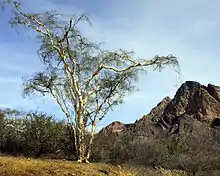Mariosousa heterophylla
Mariosousa heterophylla, also called Palo Blanco tree,[3] palo liso, guinola[4] and Willard Acacia, is a normally evergreen plant in the genus Mariosousa native to Mexico. The Spanish common name translates into 'white stick', defining its peeling white bark. A compound called Willardiine, that acts as an agonist in glutamate receptors, can be isolated from M. heterophylla.[5][6]
| Mariosousa heterophylla | |
|---|---|
 | |
| Scientific classification | |
| Kingdom: | |
| (unranked): | |
| (unranked): | |
| (unranked): | |
| Order: | |
| Family: | |
| Genus: | |
| Species: | M. heterophylla |
| Binomial name | |
| Mariosousa heterophylla (Rose) Seigler & Ebinger[1] | |
| Synonyms[1][2] | |
| |
Description
It can grow 10–20 ft or more with a spread of 1/3 to 2/3 the height. It is a very slender tree with few branches as well as leaves. The petiolar-rachis is characteristically long and functions as a cladophyll. it has a white or yellow-colored peeling off bark. The leaves have 5–6 leaflets in the end. It may drop leaves in autumn and winter. The flowers are like catkins, rod or bottle-brush-like, white or light yellow in color. The pods are multichambered, and 3–4 in long specimens.[7] The flowers occur in pale yellow spikes.[8]
Distribution and habitat
The plant is endemic to Sonora (Sonoran desert), Mexico. It prefers rocky bajdas, slopes and arroyos from 0 to 2,000 feet elevation.[9]
 The bark of M. heterophylla
The bark of M. heterophylla
See also
References
- Seigler DS, Ebinger JE. (2018). "New Combinations in Parasenegalia and Mariosousa (Fabaceae: Mimosoideae)" (PDF). Phytologia. 100 (4): 256–259.CS1 maint: uses authors parameter (link)
- Seigler DS, Ebinger JE, Miller JT (2006). "Mariosousa, a New Segregate Genus from Acacia s.l. (Fabaceae, Mimosoideae) from Central and North America". Novon. 16 (3): 413–420. doi:10.3417/1055-3177(2006)16[413:MANSGF]2.0.CO;2.
- Phillips, S. J.; Patricia Wentworth Comus (2000). A natural history of the Sonoran Desert (PDF). Arizona: Arizona-Sonora Desert Museum Press. p. 230. ISBN 0-520-21980-5.
- Dimmitt, M. A. "Acacia willardiana". Arizona-Sonora Desert Museum. ASDM Sonoran Desert Museum Digital Library.
- Klaassen, C. D.; John Barr Watkins (2010). "Toxic Agents". Casarett and Doull's essentials of toxicology (PDF). USA: McGraw-Hill Prof Med/Tech. p. 374. ISBN 978-0-07-176651-7.
- Atta-ur- Rahman (2000). "Interference of Alkaloids". Bioactive Natural Products (Part B), Part 2 (PDF). Amsterdam: Alsevier Science B. V. p. 72.
- Moore, Tony. "Acacia willardia, Palo blanco, Fabaceae Family". Government of Arizona. Archived from the original on 2002-09-18. Retrieved 2011-09-24.
- Jaeger, E. C. (1957). The North American deserts (PDF). California: Stanford University Press. p. 256. ISBN 0-8047-0498-8.
Acacia willardiana.
- "Acacia willardiana". Germplasm Resources Information Network (GRIN). Agricultural Research Service (ARS), United States Department of Agriculture (USDA). Retrieved 23 January 2018.
| Wikimedia Commons has media related to Mariosousa heterophylla. |
| Wikispecies has information related to Mariosousa heterophylla. |